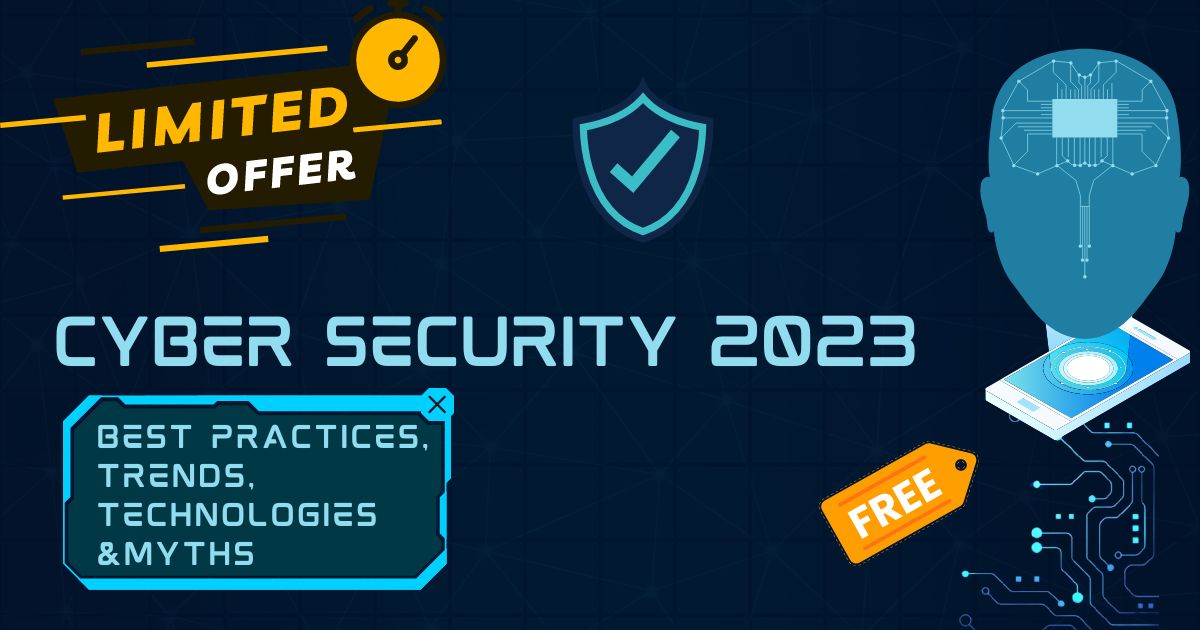Contents
What you will learn ?
- The students will learn the best practices for securing personal and organizational data.
- The students will gain a deep understanding of the importance of cybersecurity.
- The students will learn about the various impacts and outcomes resulting from cyber attacks.
- The students will gain essential knowledge about the different types of cybersecurity threats.
- The students will gain understanding of various misconceptions about cybersecurity.
- The students will understand that cybercrimes are committed for various reasons such as money, personal revenge, fun or recognition
- The students will understand the importance of incident response plan in the context of cyber security.
Advanced Usage Of Excel 2023 Course Includes
- 3.5 hours on-demand video
- Access on mobile and TV
- Full lifetime access
- Certificate of completion
Requirements
- Basic understanding of Computer Skills, Familiarity with foundational security concepts such as authentication, authorization, confidentiality.
Description
What is Cybersecurity?
Cybersecurity refers to the practice of protecting computer systems, networks, and data from unauthorized access, attacks, and damage, with the aim of ensuring confidentiality, integrity, and availability of digital assets.
Ultimate Aim of Cybersecurity:
The main goal of cybersecurity is to safeguard digital information and systems from cyber threats, ensuring that sensitive data remains confidential, systems are functioning properly, and potential risks are minimized.
Creation of New Malwares:
Every day, numerous new malwares are developed by cybercriminals. These malicious software programs are designed to exploit vulnerabilities in computer systems and networks, causing harm, stealing data, or enabling unauthorized access.
Motivation Behind Data Breaches:
The most common motivation behind data breaches is financial gain. Cybercriminals often target sensitive information like credit card details or personal data to sell on the black market or use for fraudulent activities.
Human Element in Data Breaches:
A significant percentage of data breaches involve a human element, either through intentional actions (insider threats) or unintentional mistakes, like falling for phishing scams or misconfiguring security settings.
Cyberattacks on Small to Midsize Businesses:
A substantial portion of cyberattacks are directed at small to midsize businesses due to their potentially weaker cybersecurity measures compared to larger organizations.
Importance of Software Updates:
Regularly updating software and operating systems is crucial because updates often contain security patches that fix known vulnerabilities. Cybercriminals exploit these vulnerabilities to launch attacks.
Reliable Security Software:
Using reliable security software is essential because it can detect and prevent a wide range of cyber threats, offering better protection against viruses, malware, and other malicious activities.
Training for Cybersecurity Awareness:
To educate employees about cybersecurity, conduct training sessions that cover topics like identifying phishing emails, secure password practices, and the importance of keeping software updated.
Password Creation and Use:
When creating passwords, consider length, complexity, and avoid using easily guessable information. Use a mix of letters, numbers, and special characters. Never reuse passwords across different accounts.
Caution with Unknown Sender Emails:
Emails from unknown senders can contain malicious attachments or links. Cybercriminals often use these emails to spread malware, initiate phishing attacks, or gain unauthorized access.
Regular Data Backup:
Regularly backing up data is crucial to ensure that if a cyberattack occurs, data can be restored. This prevents data loss due to ransomware, hardware failure, or other unexpected incidents.
Uninstalling Unnecessary Software:
Removing unnecessary software reduces the potential attack surface. Unused programs can have vulnerabilities that hackers exploit.
Recognizing Secure Sites:
Secure sites are indicated by “https://” and a padlock icon in the browser’s address bar. These sites encrypt data transmitted between your device and the website, enhancing security.
Benefits of Firewalls:
Firewalls act as barriers between a trusted internal network and untrusted external networks, controlling incoming and outgoing traffic. They help prevent unauthorized access and filter out malicious data.
Online Threat Education:
Understanding online threats empowers individuals to recognize and avoid them. This knowledge is vital for personal security and contributes to a safer online environment.
Two-Factor Authentication (2FA):
Two-factor authentication requires users to provide two forms of verification (e.g., password and a unique code sent to their phone) before gaining access. It adds an extra layer of security.
Patch Management:
Patch management involves regularly updating software, operating systems, and applications to address vulnerabilities and improve overall security.
Social Networking Site Caution:
Social networking sites can expose personal information to a wider audience. Exercise caution, limit sharing of sensitive data, and adjust privacy settings to prevent unauthorized access.
Protecting Sensitive Data:
Cybersecurity measures protect sensitive data from cybercriminals, hackers, and unauthorized access, ensuring data integrity and confidentiality.
Importance of Cybersecurity:
In today’s digital world, cybersecurity is crucial to prevent data breaches, financial losses, identity theft, and disruption of critical services.
Preserving Brand Reputation:
Effective cybersecurity safeguards prevent data breaches and incidents that could damage a company’s reputation, preserving trust among customers and partners.
Growing Importance of Cybersecurity:
The significance of cybersecurity continues to rise as more transactions, communication, and critical services move online, increasing the potential impact of cyber threats.
Cyber Threats and Industries:
Not all industries face equal risks from cybercriminals. Some industries, like finance and healthcare, are more attractive targets due to the value of the data they possess.
Risk to Individuals and Small Industries:
Individuals and small industries are not immune to cyberattacks, as cybercriminals often target them for financial gain, personal data theft, or as entry points into larger networks.
Interest of Attackers:
Believing you’re of no interest to cyber attackers is a mistake; they target a wide range of victims, seeking personal data, financial information, and system access.
Benefits of Cybersecurity Measures:
Cybersecurity measures offer protection against data breaches, financial losses, identity theft, and disruption of services, ensuring a safer digital environment.
Customer Confidence in Cybersecurity:
Implementing strong cybersecurity measures instills confidence in customers, showing that their data and transactions are secure, leading to better customer relationships.
National Security and Cybersecurity:
Cybersecurity contributes to national security by protecting critical infrastructure, sensitive government information, and ensuring the country’s overall digital resilience.
Business Continuity and Cybersecurity:
Effective cybersecurity measures ensure business continuity by preventing data breaches and attacks that could disrupt operations, ensuring smooth functioning.
Benefit for Mental Health:
Good cybersecurity practices reduce the risk of falling victim to cybercrimes, alleviating stress and anxiety related to potential online threats.
Consequences of Cyber Attacks:
Cyber attacks can lead to data breaches, financial losses, privacy violations, reputational damage, and disruption of services.
Financial Impact of Cyber Attacks:
Cyber attacks can result in financial losses for both individuals and organizations, stemming from theft, fraud, legal costs, and operational disruptions.
Reputation Damage from Cyber Attacks:
A cyber attack can tarnish an organization’s reputation, eroding customer trust and confidence, which may lead to loss of business.
Legal and Regulatory Consequences:
A cyber attack can lead to legal and regulatory consequences, especially if sensitive data is compromised, violating data protection laws.
Psychological Impact of Cyber Attacks:
Cyber attacks can have a psychological and emotional impact on victims, leading to stress, anxiety, and a sense of violation.
Varied Impact of Cyber Attacks:
The consequences of a cyber attack differ based on an organization’s size, industry, preparedness, and the specific nature of the attack.
Common Cyber Threats:
Common cyber threats include viruses, malware, phishing, ransomware, data breaches, and denial of service attacks.
Malware and Spread:
Malware is malicious software designed to harm systems or steal data. It spreads through infected files, downloads, or malicious links.
SQL Injection:
SQL Injection is a technique where attackers manipulate input fields to execute unauthorized SQL commands on a database, potentially gaining access to sensitive data.
MITM Attacks:
MITM stands for Man-in-the-Middle attacks, where attackers intercept and manipulate communication between two parties without their knowledge.
DoS and DDoS Attacks:
Denial of Service (DoS) and Distributed Denial of Service (DD
What You’ll Learn:
In this course, you’ll master:
- Creating web components with HTML, from basic structures to media like images, videos, and audio.
- Crafting attractive website designs using CSS for beauty and appeal.
- Understanding crucial CSS topics such as selectors, margins, padding, and more.
Web Designing & Web Development:
Discover the importance of web design and development in today’s digital world. Master the essentials like HTML5, CSS3, and JavaScript to build modern, user-friendly websites. Bootstrap, a handy framework, simplifies responsive website creation, while libraries like React and React Native allow for interactive user interfaces.
Advantages of the Course:
Enroll in this course and enjoy:
- Video lectures to simplify learning.
- Practice assignments and problem-solving support.
- Comprehensive study materials including PPT notes and source code.
- A 30-day money-back guarantee ensures your satisfaction.
Join the “Beginners Bootcamp | HTML CSS Coding for Website Development” course today and unlock your potential in web design and development!
Who this course is for:
- Students, Small Business Owners, Technology Enthusiasts and General Public
Frequently Asked Questions
- What is cybersecurity? Cybersecurity involves protecting computer systems, networks, and data from cyber threats and attacks to ensure confidentiality, integrity, and availability of information.
- Why is cybersecurity important? Cybersecurity safeguards sensitive information, prevents unauthorized access, and maintains trust in digital interactions, ultimately preserving data integrity and maintaining privacy.
- How are new malwares created daily? Cybercriminals constantly develop new malicious software (malware) by exploiting vulnerabilities in software or using social engineering techniques, resulting in a steady stream of new threats.
- What motivates data breaches? Data breaches are often driven by financial gain, theft of personal information, espionage, or even hacktivism, where attackers aim to disrupt or damage a target for ideological reasons.
- What percentage of data breaches involve human elements? A significant portion of data breaches involve human error, negligence, or malicious intent, highlighting the importance of cybersecurity training and awareness for employees.
Price & Validity
Actual Price : Rs.799/-
After 100% Discount : Rs.0/-
Valid for First 1000 Users or till the last date. Hurry up before it closes
Note : Udemy Courses listed here are offered FREE only for first 1000 users or are limited by a date. If the 1000 users limit or last date is completed, the course becomes paid.


